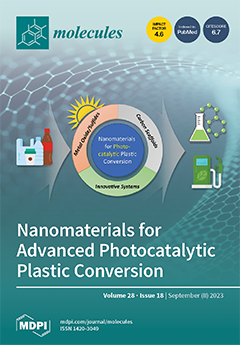Staphylococcus aureus is one of the most widespread foodborne bacteria that cause high morbidity, mortality, and economic loss, primarily if foodborne diseases are caused by pathogenic and multidrug-resistant (MDR) strains. This study aimed to determine the prevalence of
S. aureus in chicken meat in Egyptian markets. Thus, this study might be the first to assess the efficiency of different natural phenolic compounds as novel antibacterial agents against MDR
S. aureus pathogens isolated from raw chicken meat in the Egyptian market. The incidence and quantification of pathogenic
S. aureus were detected in retail raw chicken meat parts (breast, thigh, fillet, and giblets). In total, 73 out of 80 (91.3%) of the chicken meat parts were contaminated, with
S. aureus as the only species isolated. Of the 192 identified
S. aureus isolates, 143 were coagulase-positive
S. aureus and 117 isolates were MDR (81.8%, 117/143). Twenty-two antibiotic resistance profile patterns were detected. One strain was randomly selected from each pattern to further analyze virulence and resistance genes. Extracted DNA was assessed for the presence of antibiotic-resistance genes, i.e., vancomycin-resistance (
vanA), aminoglycosides-resistance (
aacA–aphD), apramycin-resistance (
apmA), and methicillin-resistance (
mecA), penicillin-resistance (
blaZ), and virulence genes staphylococcal enterotoxins (
sea and
seb), Panton–Valentine leucocidin (
pvl), clumping factor A (
clfA), and toxic shock syndrome toxin (
tst). Clustering analyses revealed that six
S. aureus strains harbored the most virulence and resistance genes. The activity of hydroquinone was significantly higher than thymol, carvacrol, eugenol, and protocatechuic acid. Therefore, phenolic compounds, particularly hydroquinone, could potentially alternate with conventional antibiotics against the pathogenic MDR
S. aureus inhabiting raw chicken meat. Hence, this study indicates that urgent interventions are necessary to improve hygiene for safer meat in Egyptian markets. Moreover, hydroquinone could be a natural phenolic compound for inhibiting foodborne pathogens.
Full article






